Sunday, August 7, 2011
Kumato, avocado, broccoli and cucumber salad with sesame dressing クマト、アボカド、ブロッコリー、キュウリの胡麻和え
I am a sucker for "new" food items at the market. I found a brown tomato called "Kumato", which was developed in Spain (I do not think this is the result of genetic engineering), and had to try it. I made a nice and healthy salad with sesame dressing.

Here is the kumato tomato (label on the left indicating this one is from Toronto, Canada. I did not know they produced tomato/kumato for export.). The right picture shows three kumatoes and a regular tomato for comparison. I skinned and then quartered the kumato for this salad. I also included blanched and still crunchy broccoli, a sliced quarter of avocado and cucumber sticks.

Sesame dressing: I first dry roasted white sesame (1 tsp) in a dry frying pan. Although the sesame has already been roasted re-roasting makes it much more fragrant). I coarsely ground the roasted sesame in a Japanese pestle and mortal or "suribachi" すり鉢 as you see in the pictures below. One small gadget you must have is this "suribachi" rake. This is a minuscule metal rake to remove all the ground material from the suribachi as you see in the middle picture below. Using this "rake" you can remove all the ground sesame from the groves of the suribachi (below right). This works well to remove items from Japanese graters especially such items as ginger or wasabi root. The more traditional form of this is made of bamboo.

I added white sesame paste or "Shiro neri goma" 白練り胡麻 (1 tbs), sugar (1/2 tsp) and soy sauce (2-3 tsp).

I served this salad with three small items; "mozuku" モズク in sweet black vinegar (in the back left), matsumae-zuke 松前漬 (center) and squid "bukkake" イカのぶっかけ, all came frozen. Kumato is a bit sweeter than regular tomatoes and has less acidity. One of our guests tried it and really liked it, although we are not too impressed.
Friday, August 5, 2011
Dried Pacific saury in mirin marinade 秋刀魚のみりん干し
No, I did not make this myself. I bought it sometime ago, frozen, and almost forgot that we had it. This is a preparation called "mirin boshi" みりん干し. Japanese love dried or semi-dried fish (This probably started out mainly as a way to preserve fish but the reduction of the water content in the fish flesh does concentrate the flavors. So now it is eaten for its taste since there are other ways to preserve fish). On our last trip to Japan, we visited stores that specialized in dried fish at the Nishiki market 錦市場 in Kyoto (picture below).
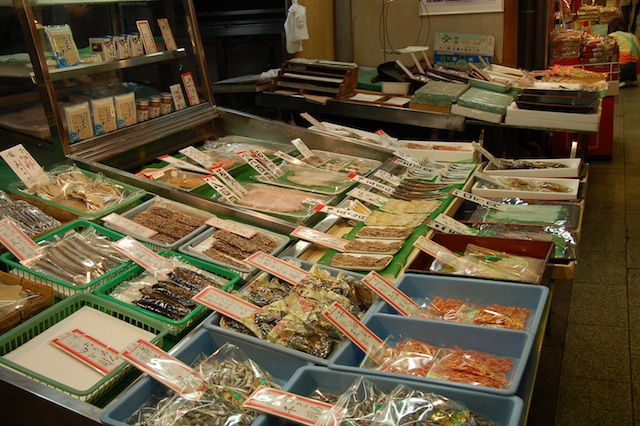
The mirin-bosh I bought was labeled as having been made in Ibaragi prefecture 茨城県. This technique of marinading in a mirin and soy sauce mixture and drying can be applied to different types of fish, for example, species of mackerel such as aji 鯵, saba 鯖, or pafici saury 秋刀魚. I recall eating it in Izakaya while I lived in Japan but they were rather sweet and often dry or even crunchy (almost candied), especially small fish like aji. I am sure if you make it at home, it may be better.
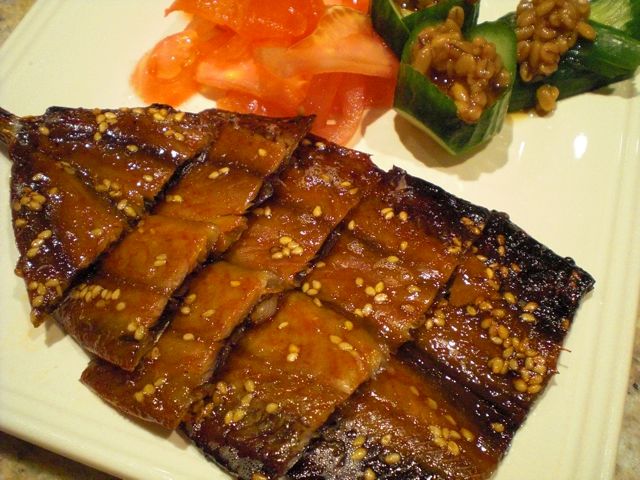
I found a package with two "sanma" fish already prepared (bone-less) in the Japanese grocery store's freezer case. I bought it for the "sake" of nostalgia (it goes well with "sake" as well). This preparation is usually grilled and served hot but some are sold already grilled (in that case, it just has to briefly warmed before serving). The one I got was not pre-grilled. After I thawed it overnight in the refrigerator, I grilled it in a toaster oven. Because of the high sugar content with mirin, it burns very easily. I lined the bottom of a baking dish with aluminum foil and placed a metal grill over it then put the mirin-boshi fish on the grill. I set my toaster oven to "broil" and started cooking the meat surface first. I carefully watched the fish as it cooked. When it started bubbling and the edges started browning I flipped the fish and continued cooking. The skin side started bubbling up and browned much faster than the meat side.
I served this with cucumber with moromi miso and slices of tomatoes sprinkled with salt. This may not have been the best example of this kind of fish; it was rather on the sweet side and not as meaty or juicy as it could have been, but it was not far from what I remembered eating in a small Izakaya in Susukino 薄野. It was nostalgic and brought back memories of good times with friends. This went well with cold sake we were having.
Wednesday, August 3, 2011
Creamed spinach au gratin ほうれん草のグラタン
One weekend, we were planning to make spinach soufflé. My wife prepared a package of spinach for this but somehow we ran out of time and decided to make the souffle later. But it is basically not feasible to make soufflé on weekday evenings. Almost one week passed after my wife cooked the spinach and there was still no souffle. Before the spinach went bad, we decided to just make creamed spinach. As a consolation prize, I decided to make it slightly more interesting by adding panko crust mixed with Parmesan cheese and calling it "au gratin".
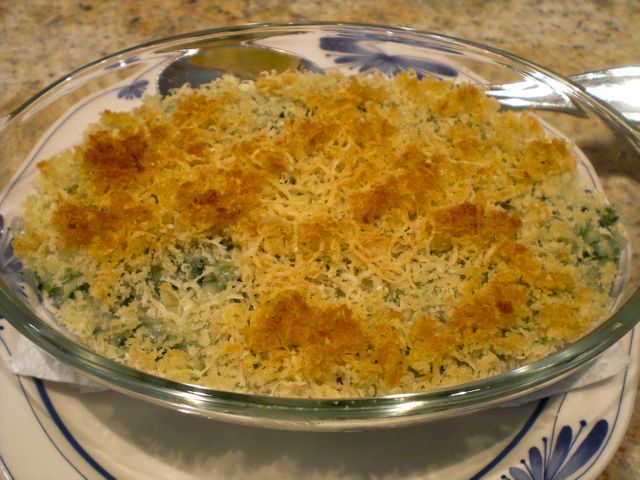

The amount of two small servings seen above.
Spinach: The package of baby spinach (about 10 oz) was cooked without additional water in a tightly lidded pan for 4-5 minutes or until wilted mixing twice of three time during the cooking. I squeezed out the excess moisture and cut into small (1/2 inch) pieces.
Spinach: The package of baby spinach (about 10 oz) was cooked without additional water in a tightly lidded pan for 4-5 minutes or until wilted mixing twice of three time during the cooking. I squeezed out the excess moisture and cut into small (1/2 inch) pieces.
Béchamel sauce: I finely chopped a shallot (one, medium). I then sauteed it in a frying pan with olive oil (2 tbs) and butter (1 tbs). I sprinkled in AP flour (about 3-4 tbs) and sauteed it for few minutes until the flour coated all the shallot pieces and got sort of wet. If you use more fat, it will be easier to make the sauce but with the flour coating the individual pieces of shallot, you can make Béchamel with much less fat. I initially added milk (1%, one cup) all at once and mixed using a silicon spatula. After the sauce thickened, If needed, I add more milk to adjust the consistency. I seasoned it with salt, white pepper and nutmeg (both freshly ground). I then added shredded aged cheddar cheese (about 1/2 cup) and the spinach.
Bread crumbs: I used Japanese panko crumbs (about 1/4 cup or more), added good olive oil (about 2 tbs) and mixed the oil and crumbs by rubbing the crumbs between my finger tips. I also mixed in grated Parmigiano Reggiano (about 3-4 tbs), You could add more on the top of the crumb layer before baking.
Assembly: I divided the creamed spinach into two small flat ramekins and spread the bread crumbs on top. I baked them at 400F in a preheated toaster oven for 7-10 minutes or until the crumbs were golden brown.
This is not as good as spinach soufflé but much more interesting than a simple creamed spinach. We had this as a drinking snack but this will be perfect with toast points or small baguette rounds.
Monday, August 1, 2011
Red snapper and cream cheese dip レッドスナッパーのクリームチーズ ディップ
After grilling a large red snapper, we had lots of fish meat leftover. I made a Japanese style salad with it but did not take pictures. My wife made this dip from the fish meat. This is based on a dip we used to make from locally produced (Northern Virginia) hot smoked trout which we used to buy occasionally. Since we hot smoked our red snapper and the fish meat had a gentle smoky flavor, we thought this may work.

She put cream cheese (one stick or 8 oz, of course, Kraft Philadelphia brand), in the food processor then added about an equal amount of the cooked hot smoked red snapper meat (bones carefully removed), lemon juice (3 tbs), horse radish (1 tbs), salt (to taste, 1/2 tsp) and blended it until creamy and all the ingredients were incorporated. She then added finely chopped dill (as much as you like, we used about 2-3 tsp).
We serve this with our favorite crackers. In this picture, you can see crackers with sesame and roasted garlic behind the glass bowl.
This is a very nice dip. We had this dip with an ice cold white wine. It is very unusual for us red wine drinkers to go for a white wine but this is what hot days will do to you. The wine was Pionero Maccerato Albarino 2009 from Rias Baixas, Galicia, Spain, which got a Wine Advocates score of 90. This one has a nice apple, melon and floral note and some mild acidity. This is a good wine to sip while eating this dip on crackers sitting outside enjoying a summer evening.
Saturday, July 30, 2011
Stewed fish head 兜煮もどき
When I grilled the whole large red snapper in a semi-Japanese style, we were left with this head (below). No self respecting person of the Japanese persuasion could bear to just cut it off and throw it out. We could have eaten the meat from the head the night we cooked the fish but we had plenty of meat from the other parts. So I decided to make something else from this.
Authentic Japanse stewed fish head or "kabutoni" 兜煮 traditionally starts with an uncooked fish head which is split in half (called "nashiwari" 梨割り) before stewing. Since we needed the head to properly display the whole grilled red fish, this fish head was already grilled (and even hot smoked). In addition, the head was really big with its thick skull and sturdy cervical vertebrae preventing me from cutting it in half short of using a reciprocal saw.
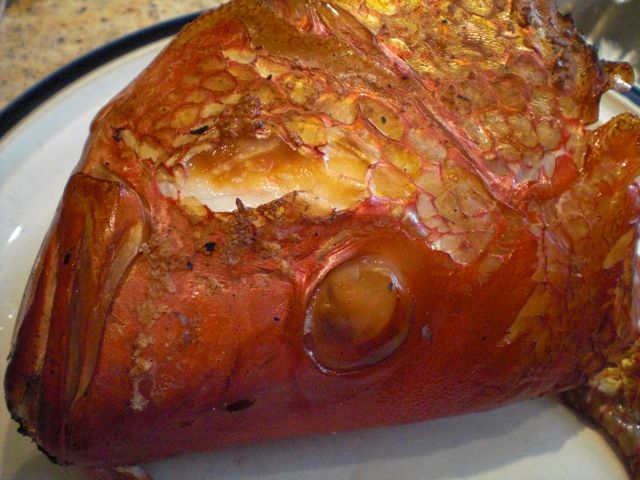
So, by no means, this was "kabuto-ni" but "kabutonioid" 兜煮もどき. Besides getting a fish head, one of the problems of "kabutoni" is the presentation. This one is particularly not good. It almost looks like a mummified fish head (below) dug up from one of the Egyptian pyramids. In any case, I just simmered the grilled (hot smoked) head with dashi, mirin and soy sauce with slices of ginger. The traditional way is to place the burdock root or "gobou" 牛蒡 in the bottom of the pan and then place the fish head on top but I did not have gobou. I just placed the fish head in the pot and added daikon instead.
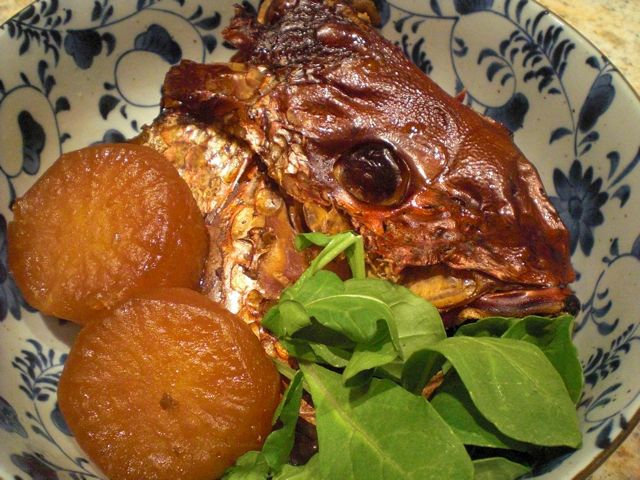
With an "otoshi buta" 落とし蓋, I simmered it for 40 minutes or so and let it cool down. I actually served this the next day after it spent the night in the refrigerator and warmed it up the next evening.
The result? Obviously not as good and real kabutoni but it had lots of meat which is a bit on the dry side but not too bad. The skin was not edible (like leather)(but neither was the skin on the rest of the fish edible). The gelatinous stuff behind the eyeballs, which connoisseurs of fish head including myself love, was not as gelatinous but was quite good (my wife graciously offered her share of the eyeballs to me). Next time, we will get a smaller red snapper and may try different dishes from the fillets and maybe a more authentic "kabutoni".
Thursday, July 28, 2011
Angel hair pasta pancake with Parmesan cheese エンジェルヘアパスタとパルメザンチーズのパンケーキ
This was made mostly for leftover control but it is a nice satisfying dish. The ingredients I had to work with were: leftover cooked angel hair pasta, one egg (while making poached eggs earlier I broke one of the yolks when I cracked it into a small dish before submerging the egg into the poaching water. Luckily I could save the egg for later use) and a small piece of red onion (less than 1/4). So this is the dish I came up with.
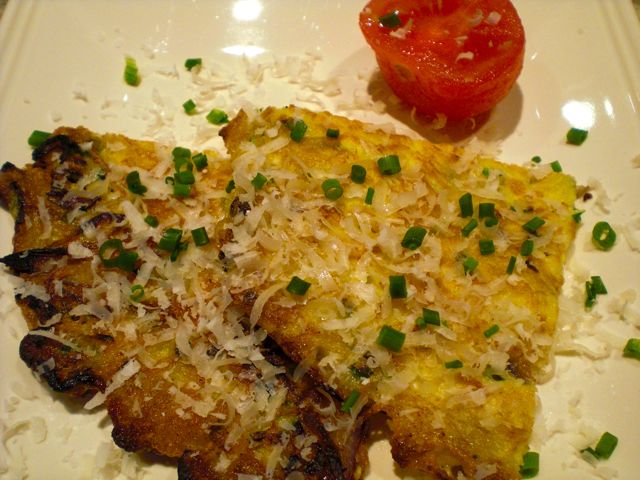
This is variation of the one I already posted. I first sauteed the red onion (thinly sliced) in a light olive oil on a medium flame. Meanwhile I mixed an appropriate amount of pasta, egg, and good amount of grated Parmigiano Reggiano (all precise measurement). I added the sauteed onion and spread the mixture in a small flying pan (the same one I used for the onion) and cooked it for 2-3 minutes on low flame. When the bottom is set and brown, I flipped it (a successful flip is all in the wrist!) and browned the other side for 2-3 more minutes until cooked and the edge was brown and crispy. I grated more Parmigiano on the top and garnished it with chopped chives. I had one last drunken tomato which I served one half per person.
This is variation of the one I already posted. I first sauteed the red onion (thinly sliced) in a light olive oil on a medium flame. Meanwhile I mixed an appropriate amount of pasta, egg, and good amount of grated Parmigiano Reggiano (all precise measurement). I added the sauteed onion and spread the mixture in a small flying pan (the same one I used for the onion) and cooked it for 2-3 minutes on low flame. When the bottom is set and brown, I flipped it (a successful flip is all in the wrist!) and browned the other side for 2-3 more minutes until cooked and the edge was brown and crispy. I grated more Parmigiano on the top and garnished it with chopped chives. I had one last drunken tomato which I served one half per person.
Tuesday, July 26, 2011
Octopus and Nagaimo stir fly with garlic 長芋とタコの塩バターソテー
I made this dish from what was left of boiled small octopus after making sumiso-ae. I adapted this from e-recipe. I would have used soy sauce instead of just salt but I followed the recipe.

Octpus: I used boiled small octopus head (body). I sliced the octopus in to thin (1/2 to 1/4 inch) strips.
Nagaimo: I used nagaimo (2 inch segment), peeled, sliced (1/4 inch) and cut in half rounds.
I put a pat of butter (1 tsp) in a frying pan on medium low flame. When the butter melted, I added garlic (1 small glove, finely chopped). When the garlic became fragrant (1 minute), I added the nagaimo rounds and fried both sides (1-2 minutes each). I then put in the octopus and sauteed for another 1 minute. I added salt (1/3 tsp) melted in warm water (2 tbs) and mirin (2 tbs). I braised it until the liquid is almost all evaporated. I garnished with a very small pat of butter, perilla and freshly cracked white pepper (my additions).
This is an interesting dish. The nagaimo is still a bit slimy and may not be suitable for those with slimonphobia out there but is nicely crunchy with a buttery flavor. The octopus is rather tender (relative to other cooked octopi) and nice garlic taste. Perfect drinking snack for sake.
Subscribe to:
Comments (Atom)
